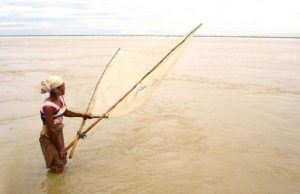Memo #164
By Tashi Tsering – ttsering [at] interchange.ubc.ca
 What would an ideal regulatory system to manage an international river look like? Some have called for an innovatively designed regulatory authority for international rivers, such as the Ganga-Brahmaputra river system in the Himalayan region. Existing models are not compatible with the geopolitical conditions in South Asia. Rather than furthering traditional nationalist approaches, the new design must take into account the people living in the region.
What would an ideal regulatory system to manage an international river look like? Some have called for an innovatively designed regulatory authority for international rivers, such as the Ganga-Brahmaputra river system in the Himalayan region. Existing models are not compatible with the geopolitical conditions in South Asia. Rather than furthering traditional nationalist approaches, the new design must take into account the people living in the region.
Existing models are designed mainly for developed countries. When applied to developing countries, they tend to produce a host of problems including corruption, forced relocation, military crackdown, and environmental destruction. In addition, the sharing of economic benefits of joint management is not sufficient for bringing India and China, the two main riparian countries, to work together. They have differing priorities in the region, evident in the issue of political stability.
Aside to being the home of the Himalayas, a world “Biodiversity Hotspot,” the Ganga-Brahmaputra region is also a zone of conflict and ethnic unrest. This area is home to a significant “tribal” population in Northeast India and Tibetans in China, who are embroiled in conflict with the state. There are also border disputes in the region between India and China, making the design of a regulatory authority for the basin extremely complex.
Traditional nationalist approaches to managing international rivers, such as those used by the Mekong River Commission, are most likely to further marginalize the “tribal” or “minority” peoples living in the region. The challenge is to design a river basin authority that will directly improve people’s livelihood and cross-border relations.
One possible approach in designing an ideal regulatory system would be to reformulate the task from the development and strategic interest of member states to the development and livelihood security of people living in the region.
A framework for multilateral cooperation based on human interest or a human development approach is essential to produce desirable social, environmental, and economic benefits. Such an approach is also more likely to improve cross-border relations.
About the Author:
Tashi Tsering – PhD candidate in Resource Management and Environmental Studies, The University of British Columbia. Guest Editor for Theme: “Water, Scarcity, and the Frontiers on the Tibetan Plateau“.
Links:
- An extended version of the Memo is available on The Third Pole “A New Course for the Brahmaputra,” August 16, 2012. (By Tashi Tsering)
- Managing South Asia’s Himalayan Rivers, East Asia Forum, June 9, 2012.
- Overview – Himalaya, Conservation International.
- China’s Water Politics: In Whose Interests? Portland State University, 2003 (By Tashi Tsering).
- Human Development, United Nations Development Programme.
- Indian Media and Misinformation on Chinese Dam on the Brahmaputra, The Tibetan Plateau Blog (By Tashi Tsering).
Related Memos:
- See Tashi Tsering’s Memo, China’s Plans to Divert Water on the Tibetan Plateau (Memo #110)
